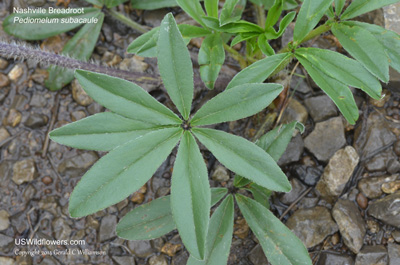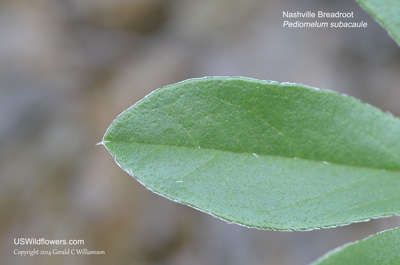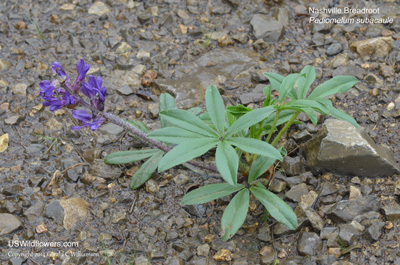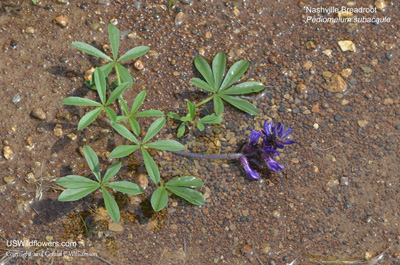Nashville Breadroot, Whiterim Scurfpea, Glade Potato - Pediomelum subacaule
|
Pediomelum subacaule - Nashville Breadroot, Whiterim Scurfpea, Glade Potato. There are over 20 Pediomelum (Indian Breadroot) species in the United States, but only about 5 in the east, and only one of those (P. canescens, Buckroot) has relatively wide eastern U.S. distribution. The other eastern species have very narrow distribution, as is the case with Pediomelum subacaule, which is found only in limestone cedar glades in two northwest Georgia counties, four counties in Alabama, and in several counties in middle Tennessee. It is considered rare in both Alabama and Georgia. The plants presented here were photographed in a cedar glade in the Catoosa County, Georgia part of the Chickamauga Battlefield section of the Chickamauga and Chattanooga National Military Park.
The species epithet subacaule references the minimal stem of the plant - the multiple leaf stalks arise directly from the underground root, as does the leafless floral stem.
Found in:
AL, GA, TN
Leave comments on Pediomelum subacaule at this link. | 
Distribution of Pediomelum subacaule in the United States and Canada:

Blue=Native; Grey=Introduced
Map from USDA Plants Database:
USDA, NRCS. 2017. The PLANTS Database (http://plants.usda.gov, 08 May 2025). National Plant Data Team, Greensboro, NC 27401-4901 USA.
Search Our Database: Enter any portion of the Scientific, Common Name, or both.
Do a general Google search of the entire site:
#ad
 Follow USWildflowers on Twitter
#ad
| | Site: Chickamauga Battlefield Cedar Glade, Catoosa County, Ga Date: 2014-April-29 | Photographer: Gerald C. Williamson
Nikon D7000
Tamron SP 90MM f/2.8 AF Macro | | The inflorescence of Pediomelum subacaule is a hairy raceme of about 3 inches long, bearing many pea-like dark purple flowers. | | 
| | Site: Chickamauga Battlefield Cedar Glade, Catoosa County, Ga Date: 2014-April-29 | Photographer: Gerald C Williamson
Nikon D7000 | | The palmately compound leaf of Pediomelum subacaule has five to seven leaflets which have hairs on the central vein and margins. The leaves are up to about 2 inches long. | | Click on the photo for a larger image

| | Site: Chickamauga Battlefield Cedar Glade, Catoosa County, Ga Date: 2014-April-29 | Photographer: Gerald C Williamson
Nikon D7000 | | The appressed hairs on the margins of the leaflets give them a white rim, contributing to one of the common names - "Whiterim Scurfpea". | | Click on the photo for a larger image

| | Site: Chickamauga Battlefield Cedar Glade, Catoosa County, Ga Date: 2014-April-29 | Photographer: Gerald C Williamson
Nikon D7000 | | The leaves arise directly from the underground root on silver-haired stalks. The flowering stalks are also hairy. The plant grows in rocky limestone glades, and dieing back to the root by the time the glades dry out to an almost desert-like climate in early summer. | | Click on the photo for a larger image

| | Site: Chickamauga Battlefield Cedar Glade, Catoosa County, Ga Date: 2014-April-29 | Photographer: Gerald C Williamson
Nikon D7000 | | While the plant is semi-prostrate, it may be up to 12 inches high. The cedar glade environment where Nashville Breadroot grows has thin soil over limestone, so during the frequent spring rains the soil is saturated. The plant emerges from the ground in early spring, flowering by mid-spring (April / May) and then the plant dies back to the underground root when the summer heat, lower rain levels, and thin soil dry the glades to desert-like moisture levels. The genus common name "Indian Breadroot" implies edibility of this root, perhaps by grinding it into flour. | | Click on the photo for a larger image

|
References used for identification and information:
|
|
| |
| #ad
|
|







